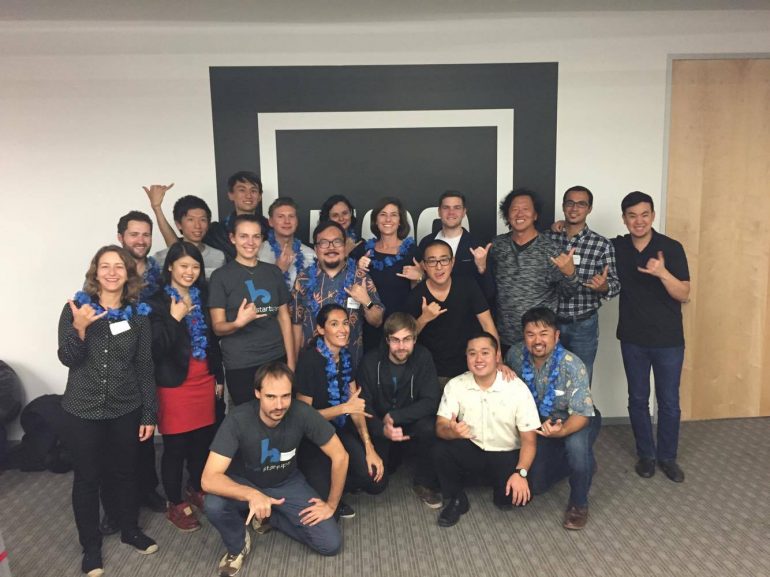Towards the end of 2015, we had a working, in-house app people were showing a lot of interest in. We came to the conclusion that an accelerator would help us take the project to the next level and subsequently started to doing interviews. After a few noes, we received a letter of intent from a Honolulu-based tech startup accelerator. We locked in our flights, packed our bags, got an apartment in Hawaii and headed south!
The four-month experience was unforgettable and overall positive, but along the way we made some mistakes and learned a lot. Here’s a sliver of what you need to know if you head to the US to join an accelerator.
Finding an Accelerator
When we started our search, we were unfamiliar with the accelerator landscape, and it turned out there were a lot of them. The best place to start is AngelList and F6S for programs that are currently accepting applications.
Average US "deal" for accelerators is about 40K for 5.5% equity. #seedrank
— Sylvain Carle (@froginthevalley) March 11, 2016
Not all accelerators are the same, they vary in deal terms, structure, network and more. However, you can get a good sense of the quality by checking out accelerator rankings websites like Seedrank.
In the end, you only get out of an accelerator what you put in. The money is nice because it lets you work exclusively on your stuff. However, we got more value out of the conversations, perspective, isolation and hard work than anything else.
Before you step foot on a plane
There are a few things you need to figure out logistically before you fly.
- Health Insurance
- Passport Renewal
- Get a USD Credit Card
- Get a USD Corporate Bank Account
- Accommodations (we stayed at a hostel for the first week, got our feet on the ground, then saw a few places before signing a rental agreement)
- Get a Lawyer (we use LaBarge Weinstein)
- Get an Accountant (we use BDO)
These are all pretty straightforward; the lawyer and accountant are for guidance. Anything can happen once you arrive, so you’ll need to make decisions quickly – having an expert on the end of a phone line is the best advice I can give. The accelerator has its own agenda just as you have yours, so having someone who can give you unbiased, objective guidance is crucial.
If you are formalizing the “equity for cash” piece when you get to the US make sure you know exactly when you’ll be receiving the cheque, how the transfer will be done, and if they can invest in a Canadian Corporation (this one is important, I’ll talk about it later).
Crossing the Border
Disclaimer: I’m not an immigration lawyer, I just went through this process. Take it all with a grain of salt and don’t get into trouble then say “a guy on BetaKit told me this was okay.” (we strongly second this disclaimer, ed.)
Canadians have it pretty easy when it comes to crossing the border. We’re one of two countries (the other is Bermuda ✊), whose citizens can enter the US and spend time there without a visa (up to 6 months). However, it is up to the officer at customs whether he/she wants to permit you to enter. To make things easy for them, package what documents you have into a folder and carry it with you as you go through customs. There are law firms that specialize in generating these packages for corporate employees at outrageous fees. Don’t let your lawyer fear monger you into buying a package, just explain the following to the customs official.
You are traveling for business, you’ll be there for (x) days, the experience is comprised of workshops and sales training. If asked, you aren’t getting paid by any US corporation for services rendered (which is true).
So you need a US Corporation?
I’ve heard this from a few fellow Canadian entrepreneurs now, so it’s worth mentioning.
US-based accelerators like investing in US C-Corps.
It’s easier for them logistically, in some cases it’s legally required by the fund, reduces overhead, and it’s what they know. Don’t wait to find out if this is the case for you, just ask them right out of the gate. If you do end up needing a US C-Corp to take the investment, we used Clerky, however at the time Stripe Atlas wasn’t yet available and seems like the better option.
These are easy enough to set up and an affordable alternative to a firm. If you’re going through this process and feel stuck, feel free to reach out to me.

Beware of Unicorn Syndrome
Silicon Valley has the rest of the world’s nuts in a vice. You can see it here when someone introduces themselves as “so and so from Silicon Valley,” proceeded by “Ooos and Ahhhhs.” Startups, design thinking, and technology have come a long way from this legacy dogma towards an Asia infused, global perspective. Investing has not.
The Accelerator model has gained a lot of popularity based on a relatively simple thesis. Make a bunch of small, early bets and one giant success will pay for all the losers.
This ‘all or nothing’ mentality means the accelerator is incentivized to push you in directions that might jeopardize your company’s future on a gamble. You’ll talk to hundreds of people about your business from varying backgrounds and levels of expertise, in the end, you have to listen to your gut and put the company (and customer) first.
Accelerators = Momentum
Accelerators give you momentum. When you pitch your business behind closed doors to hundreds of outsiders you develop pattern recognition for the types of questions you’re going to get and how to best answer those questions. They help you focus, build product fast, and curate a narrative that is attractive to investors. Going south and coming back simply makes the narrative a little more exotic.


